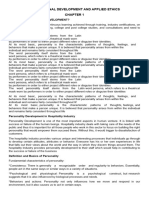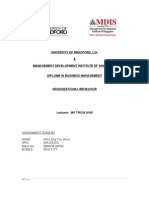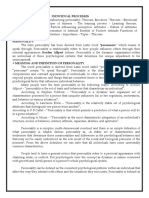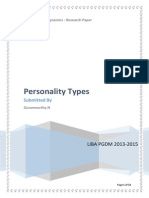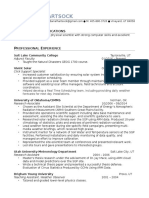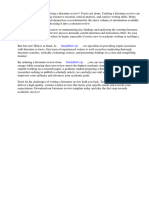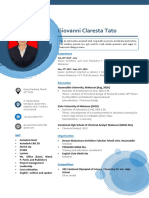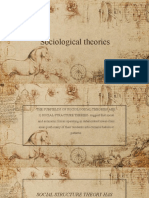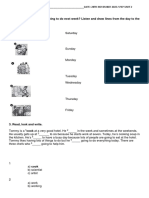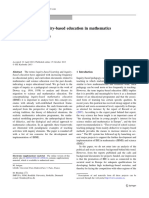FACULTY OF NURSING AND ALLIED HEALTH SCIENCES
PD101
PERSONALITY DEVELOPMENT
PERSONALITY DEVELOPMENT
Name: P. M. N. HARSHANI
Rg NO: OUM30068
Email: harshinimali1984@gmail.com
077 2458580
Tutor’s name: Dr. Kithsiri Edirisinghe
Learning Centre: IIHS, walisara, Sri lanka
MAY 2021
1
� TABLE OF CONTENT
INTRODUCTION…………………………………………………………………………….4
CONTENT
1) PERSONALITY DEVELOPMENT……………………………………………6
I. What is Personality Development?
II. Definition of Personality
III. Determinants of personality
IV. Attributes to “Good Personality”
• Physical Status
• Behavior
• Psychology
• Values
• Communication
2) PUBLIC RELATIONSHIP ……………………………………………………15
I) What is the Public Relationship (PR)
II) How importance of public Relationship for Nurses
III) How to improve Public Relationship in hospital
3) PERSONAL DEVELOPMENT PROGRAM…………………………….18
I) How arrange Personality Development program.
II) How delivery this program
• Via Video Presentation
• Ask questions from audience
2
�CONCLUSION ……………………………………………………………………………………21
REFERANCES ……………………………………………………………………………………22
3
� INTRODUCTION
Nurses have many duties, including caring for patients, communicating with nursing,
medical, non-medical staff and other health care professionals and other members of
society. Not only that, Roles of the nurse are:
• Coordinator
• Communicator
• Teacher
• Counselor
• Manager
• Leader
• Team player
• Motivator
• Advocator
There are many characteristics that a nurse must achieve to performs the above
roles. So, nurses must improve their personality to achieve to play above roles.
But I saw those personality weaknesses of nurses in my wards. There I noted
firsthand their attitudes, personal and professional life of weaknesses.
As a result, we face so many problems in our ward.
• There are many patient complaints about the rude attitude and luck of care in
nursing.
• Lack of team work among other health care professionals.
• Multiple incidents of disrespectful behavior towards nurses and ward managers.
• Lack of physical status.
Ex: clothing
Posture
Figure
4
�• Lack of communicating skills.
Ex: When using telephone
When doing admission procedure and other intervention
• Negative attitudes.
Ex: Apathy
Hate
Ignorance
Hostility
• Lack of attention for place appearance, ward arrangement and carefulness when
doing using equipment in the ward.
In this assignment, I need to enhancing the professional and personal life of the
nurses in my ward. So, I organized a program to aid personality development of
our nursing colleagues.
There I try to list out following areas with my assignment.
1. What is Personality.
2. How important it is to nurses.
3. How develop, improve, or change personality.
4. What is the public relationship and important it for nurses.
5. Arrange a personality development program for nurses.
5
� 1. PERSONALITY DEVELOPMENT.
WHAT IS PERSONALITY?
What does it mean when people say you have a nice or bad personality? Personality
is a mirror of what you do and say. Essentially, your personality defines who are you. Your
behaviour reflects your personality and informs how different you are from others. A
common saying in field of personality psychology is; “Some things change; some things
stay the same.” According to Allport (1961), “Personality is a dynamic organisation, inside
the person, of psychophysical systems that create the person’s characteristic patterns of
thoughts, feelings and behaviours.” The continuities, consistencies and stabilities of
personality traits and dispositions over time define personality development (Larsen &
Buss, 2008).
Social identity is a part of human personality. Social identity is about how you present
yourself to others. Social identity is a theory formed by Henri Tajfel and John Turner to
understand the psychological basis of intergroup discrimination. Social identity is the self
that is show to other people. This is the part of ourselves that we use to create an
impression, to let other people know who we are and what they can expect from us. Tajfel
6
�(1979) proposed that the groups (for examples, social class, family, study group) which
people belonged to were an important source of pride and self-esteem. Groups gives us a
sense of social identity: a sense of belonging to the social world. Therefore, we divided
the world into “them’ and ‘us’ based through a process of social categorization. Social
identity theory states that the in-group will discriminate against the out-group to
enhance their self-image. Tajfel and Turner (1979) proposed that there are three mental
processes involved in evaluating others as “us” or “them”. There are social categorization,
social identification and social comparison.
Identity has an element of continuity because many of its aspects such as gender and
ethnicity are constant which means that people can count on you to be the same person
tomorrow as you are today. Contrast means that your social identity differentiates you from
other people. An identify is what makes you unique in the eyes of others. Identity develops
over time through relations with others. For many people, the development of an identity
follows a period of experimentation, but for others it happens more easily by adopting ready-
made social roles. We will further discuss how people develop their identity by choosing what
they like to call attention to about themselves in their self-identities.
What is thing we call personality? “The characteristics or blend of characteristics that make a
person unique.” (Weinberg & Gould, 1999). An individual’s personality is the complex of
mental characteristics that makes them unique from other people. It includes all of the
patterns of thought and emotions that cause us to do and say things in particular ways. At a
basic level, personality is expressed through our temperament or emotional tone. However,
personality also colours our values, beliefs, and expectations. There are many potential
factors that are involved in shaping a personality. Research by psychologists over the last
several decades has increasingly pointed to hereditary factors being more important,
especially for basic personality traits such as emotional tone. However, the acquisition of
values, beliefs, and expectations seem to be due more to socialization and unique
experiences, especially during childhood.
7
�DEFINITION OF PERSONALITY
Etymological Meaning of Personality - English word 'Personality' has been derived
from the Latin word 'Persona'. The word 'Persona' first used in Greek for meaning of
theatrical mask which the Greek actors commonly used to wear on their face before
coming to the stage for acting. In this sense, in the olden days’ personality was meant
the outward appearance of a person. Today the term personality is explained in various
ways.
Definitions of Personality: - Personality has been defined by different psychologists in
different ways. Following are some of the definitions of personality:
1. According to R.B. Cattell - "Personality is that which permits a prediction of what
a person will do in a given situation."
2. According to Allport - "Personality is the dynamic organization within the
individual of those psychological systems that determine his unique adjustment
to his environment."
3. According to Morton Prince - "Personality is the sum total of all the biological
innate disposition, impulses, tendencies, appetites and instincts of the individual
and the acquired dispositions and tendencies."
4. According to Schoen - " Personality is the organized system, the functioning
whole or units of habits, disposition and sentiment that mark off any one
member of a group being different from other members of the same group."
5. According to Warren's Dictionary - "Personality is the integrative organization of
all the cognitive, affective, conative and physical characteristics of an individual
as it manifests itself in focal distinction from others."
8
�6. According to Kemp - "Personality is the integration of those system of habits that
represents an individual's characteristics adjustment to his environment."
7. J.P. Guilford defined personality as an integrated pattern of traits.
8. McDougall regards integration of personality as integration of intellect and
integration of character.
9. According to Munn - "Personality is the whole individual considered as a whole.
Personality may be defined as the most characteristic integration of an
individual's structures, modes of interests, attitude, behavior, capacities, abilities
and aptitudes."
10. According to J.F. Dashiell - "Personality is the sum total of behavior trends
manifested in social adjustments."
11. According to Healy William - personality as "an integrated system of habitual
adjustment to environment particularly to social environment."
12. Kurt Lewin considers personality as "a dynamic totality of systems."
13. According to R.M. Ogsten - "Personality is the expression of man's inner life,
character is the expression of what he does or achieves."
9
�DETERMINANTS OF PERSONALITY.
1. Heredity
Hereditary factors may be summed as constitutional biological and physiological factors.
The constitution of an individual is an effective factor in determining the type of his
personality. There are be three types of personality; short and stout, tall and thin, and
muscular and well proportioned. Height, weight, physical defects, health and strength
affect personality and contribute to personality development do so as a result of
interactions with the particular social environment in which people live. For instance, your
genetically inherited physical has an impact on how others see you and subsequently, how
you see yourself. These largely hereditary factors are likely to cause you to feel that you
are nice-looking, ugly, or just adequate.
Biological factors refer to the working of the nervous system, glands, and blood chemistry
that determines our characteristics and habitual modes of behaviour. Adrenal gland,
thyroid gland, pituitary gland and endocrine gland affect personality. Adler points out that
personality defects lead to the development of inferiority complex and the mental
mechanism of compensation. This aspect also includes the mental ability of the child. It is
this ability which enables him to mould the social environment according to his
requirements.
Intelligence is mainly hereditary. Persons who are very intelligent can make better
adjustment in home, school, and society than who are less intelligent.
Sex differences play a vital role in the development of personality of individual. Boys are
generally more assertive and vigorous. Girls are quieter and more injured by personal,
emotional and social problems.
2. Psychological factors
These include our motives, acquired interests, our attitudes, our will and character, our
intellectual capacities such as intelligence, for examples, the ability to perceive, to observe, to
imagine, to think and to reason. These factors determine our reactions in various situations and
10
�thus affect our personality, growth and direction. An individual with a considerable amount of
will power will be able to make decisions more quickly than others.
3. Environment
Some scientists are biologically oriented, while others stress on environment and
experiences. Today, many developmental scientists see heredity and environment as
fundamentally intertwined (Parke, 2004) and also constantly interacting to mould to the
developing person (Hetherington et al., 2006). They see both as part of a complex development
system (Gottlieb, 1991). It is the social environment, that he comes to have moral ideas,
social attitudes and interests. The important aspects of the environment are as follows:
i. Physical Environment.
It includes the influence of climatic conditions of a particular area or country on
man and his living.
ii. Social Environment.
The child has his birth in the society. He learns and lives there. Hence, the social
environment has an important say in the personality development of the child.
iii. Family Environment.
The family is the first context for a child entering the physical world.
The children themselves have a significant influence. This perspective looks
beyond the ages and stages of child development to the large context in which
children grow (Gordon & Browne, 2004). Lev Vygotsky (1896-1934) described
learning as the construction of knowledge within a social context and
development could not be separated from its social context. The type of
training and early childhood experiences received from the family play an
important role in the development of personality.
11
�ATTRIBUTES TO “GOOD PERSONALITY”
1. Physical status: (How you look)
posture
• Your body speaks on behalf of you
• Act likes at Unique Person
• The method
– Hold your head and chest high
– Keep your spine straight
– Legs straight, together
– Arms, hands either side
– Sit on the 45 degree, legs together
– No scratching, break dance
– How to sneeze, cough
– Walk straight, arm movement
Clothing
• Appropriate Attire
– Uniform
• Color
• Clean
• Ironed
• Attractive
12
� Figure
• Height
• Weight
• Face
• Hair
• Nail
• Skin
• Smell
2. Behavior: (How you do thing)
Negative Behavior Positive Behavior
• Hostility Cooperation
• Prejudice Acceptance
• Apathy Interest
• Ignorance Respect
• Hate Love
3. Communication: (Your expressions)
• Active listening
• Words
• Tone
• Non-verbal
• Telephone using
• Silence
13
� 2. PUBLIC RELATIONSHIP (PR)
Hospitals and specifically care givers including nurses in many developing nations
have been criticized for lack of human touch in their approach. Pressures and conflicts
often arise in the areas of health care delivery. These all demand the role played by public
relations practice. Nurses must therefore be good public relations practitioners in order
to forestall conflicts and maintain cordial relationship amongst their various clients.
Nurse managers should see public relations as a planned activity and as a management
function.
14
�15
� 3. PERSONALITY DEVELOPMENT PROGRAM
Steps for the arrangement Personality Development Program.
– Fix date and time.
– Select appropriate place
Ex: The auditorium in hospital
– Select guest and group for program
Ex: nurses are in my ward and other wards.
– Get permission from top management
Ex: From hospital Director
From Chief Nursing Officer
From ward sister or ward incharge
– Invite to gest and selected group
– Make time table for program
– Arrange a simply tea party for participated group
– Ready video presentation, guideline for this program
Objectives of this personality Development Program
1) To introduce Personality Development, concepts, and importance of
personality development for nurses
2) To introduce public relationship and how improve PR for nurses
3) To improve self-confidence for nurses.
4) To improve collaborative, communication skills
5) To discuss what are difficulties when doing nursing care and
communicating in the hospital.
16
� PROGRAM DETAILS
SESSION 01:
❖ Self- introduction
❖ Introduce personality
❖ How to develop personality as a nurse
(Specially discuss about posture, clothing and figure)
SESSION 02:
❖ Discuss about communication and how improve communication skills as a nurse.
- Active listening
- Words and tone
- Non-verbal communication.
SESSION 03:
❖ Discuss manners are when using telephone and how to keep good conversation.
Dos:
- If you answer the phone answer within three rings
- Greeting
- Identify your self
- Ask for the person you need to contact
- Thank the person
17
� - Use the best tone
Don’ts:
- Ask who is speaking
- Leave the line open
- Unattainable promises
- Eat, drink or chew
- Lose your temper
SESSION 04:
❖ Discuss about positive and negative behaviors
SESSION 05:
❖ Introduce Public Relationship
❖ How improve PR for nurses
SESSION 06:
❖ How to arrange clean and beautiful environment in the ward
❖ How to use equipment safely and responsibilities for using equipment
18
�SESSION 07:
❖ Discuss about motivation
❖ Team building
❖ How important “smile” for nurses.
Top 15 Inspirational
Quotes about Smile _ Keep Smiling Quotes.mp4
(video presentation)
19
� CONCLUSION
This assignment is analysis of personality development and public relationship. And also,
I try to identify personality weaknesses in my nursing carrier. So, I organized a personal
development program to enhance their personality and public relationship.
My goals are in my assignment, to improve personality and how it applies for the nursing.
Actually, how keep good relationship with patients, medical staff, non-medical staff and
also within our nursing carrier.
I faced so many difficulties during this program. Such as select date and time, place and
select target group. It was challengers for me during to organize this program. However
I try to achieve my goals when doing this assignment.
(wards 30009)
20
� REFERENCES
Bowlby, J. (1985). Working and Caring. In Mooney, C. G. (2010). Theories of attachment: An
introduction to Bowlby, Ainsworth, Gerber, Brazelton, Kennell, and Klaus. MN: Redleaf.
Erikson, E. H. (1970). Erikson identity. Retrieved February 14, 2011, from
http://www.haveford.edu/psych/ddavis/p109g/erikson.identity.html
Gordon, A. M., & Browne, K. W. (2004). Beginnings & Beyond (6th ed.). NY: Delmar.
Gottlieb, G. (1991). Experiential canalization of behavioural development theory. In Papilia,
Olds & Feldman, (2007). Human development (10th ed.), (p.78), NY: McGraw Hill.
Gottlieb, G. (2000). Environmental and behavioural influences on gene activity: Current
Directions in psychological Science, 9, 93-97. In Berk, L. E. (2005). Infants and children:
Prenatal through middle childhood (5th ed.). MA: Pearson.
Hetherington, E. M., Parke, R. D., Gauvain, M., & Locke, V. O. (2006). Child Psychology: A
contemporary viewpoint. New York: McGraw Hill.
Papilia, D. E., Olds, S. W., & Feldman, R. D. (2001). Human development (10th ed.) NY:
McGraw Hill.
Parke, R. D. (2004). The Society for Research in Child development at 70: Progress and
Promise. In Papilia, Olds & Feldman, (2007). Human development (10th ed.), (p.78). NY:
McGraw Hill.
Shore, R. (1997). ‘What have we learned?’ in Rethinking the brain’. New York: Families and
Work Institute.
Tajfel, H. (1978). The achievement of group differentiation. In H. Tajfel (Ed.), Differentiation
between social groups: Studies in the social psychology of intergroup relations (pp. 77-98).
London: Academic Press.
Tajfel, H., Turner, J. C. (1979). An integrative theory of intergroup conflict. In W.G. Austin &
S. Worchel (Eds.), The social psychology of intergroup relations (pp.33-47). Monterey, CA:
Brooks/Cole.
21
�22



